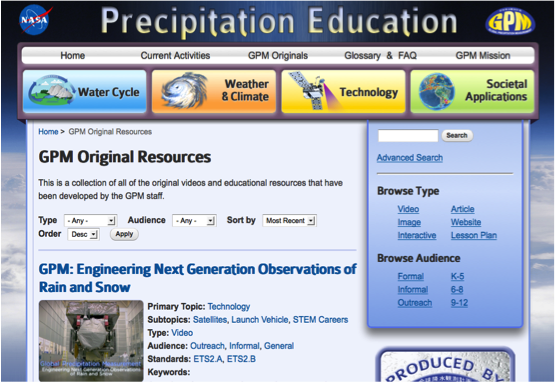GPM Resources - GPM
GPM Resources
Protocols:
- Precipitation Protocols: Students measure daily rainfall using a rain gauge, daily snowfall using a snow board, total snow accumulation on the ground, the equivalent depth of rain for both new snow and snow pack, and use techniques from the Hydrology Investigation to measure pH of rain and melted snow.
Optional Protocols:
- Cloud Protocols: Students estimate the amount of cloud and contrail cover, observe which types of clouds are visible and count the number of each type of contrail.
- Relative Humidity Protocol - Students measure the relative humidity using either a digital hygrometer or a sling psychrometer.
- Barometric Pressure Protocol - Students use an aneroid barometer to measure barometric pressure.
- Max/Min/Current Air Temperature Protocol - Students use a maximum/minimum thermometer mounted in their instrument shelter to measure current temperature and the maximum and minimum temperatures for the previous 24 hours. Students may also collect current temperature only.
- Digital Multi-Day Max/Min/Current Air and Soil Temperature Protocol - Students use a digital multi-day maximum/minimum thermometer mounted in their instrument shelter to measure the maximum and minimum air and soil temperatures for up to six previous 24-hour periods.
- Optional Automated Soil and Air Temperature Monitoring Protocol - Students use a data logger and temperature sensors to measure air temperature and soil temperature at 5, 10, and 50 centimeter depths every 15 minutes for extended time periods.
- Gravimetric and Volumetric Soil Moisture Protocols (draft): Students measure soil water content by mass and volume.
- pH Protocol - Students will measure the pH of water using either pH paper or a pH meter.
Learning Activities:
- Water Detectives - Students will investigate how they use their senses for observation and why we use instruments to collect data.
- The pH Game - Students will create mixtures of water samples, soil samples, plants and other natural materials to better understand the importance of pH levels.
- Model Your Water Balance - Students will model the changes in soil water storage over a year.
- Just Passing Through - Beginners: Beginning students are introduced to the basic concepts of how water passes through soil in an activity which illustrates the scientific method
- Just Passing Through: More advanced students investigate the effects of soil characteristics on water infiltration and the chemistry of water that has passed through soil.
- From Mud Pies to Bricks: Students make mud pies by adding water to the various soil components, letting them dry and observing the pie's characteristics.
- Cloud Watch - Students monitor clouds and weather to begin to understand the connections between the two.
- What Can We Learn About Our Seasons? Students develop a qualitative understanding of the characteristics and patterns of seasons and highlight the relationship of seasons to physical, biological and cultural markers.
- All Year Long: Each student will keep a science journal during each of the four seasons. Students will record observations of the general outdoor environment they visit and then will make observations of one specific item from the habitat in each season. At the end of the school year, students will compare of their seasonal drawings and share their results with the class.
- Earth System Science Poster and Activity Guides (including a new MY NASA DATA digital poster)
Related GPM Lesson Plans and Activities:
- Rain Gauge Design Challenge: Students design, build, and test an instrument to measure precipitation. As an informal lesson/activity (alternate version) or as a formal classroom lesson.
- Geographical Influences on Climate: Students will compare the climatograms for different locations around the United States to observe patterns in temperature and precipitation.
- Survivor: Earth Lesson Series: Students learn about local and global water issues through hands-on activities done largely outdoors and include scientific data collection based on simplified GLOBE protocols.
- Weather and Climate iQuest: Students learn how weather and climate are shaped by complex interactions involving sunlight, the ocean, the atmosphere, clouds, ice, land, and life forms.
- Earth Wheel: A physical interactive that allows students to explore and compare data from four current satellite missions: Aquarius, GRACE, Terra and TRMM. For a full lesson plan and accompanying webquest, visit: http://go.nasa.gov/1vWhHMZ
- Exploring the Water Cycle: A lesson to teach students about the water cycle and the forces that drive the processes that move water through Earth's systems.
- The Water Cycle: In this one-hour long activity, students participate in a webquest to learn about the water cycle, and then build a mini-model of the water cycle to observe how water moves through Earth's four systems.
- Water Cycle Webquest: A longer version of the webquest from the previous activity, students learn a little about the GPM mission and then focus on online resources about the water cycle.






